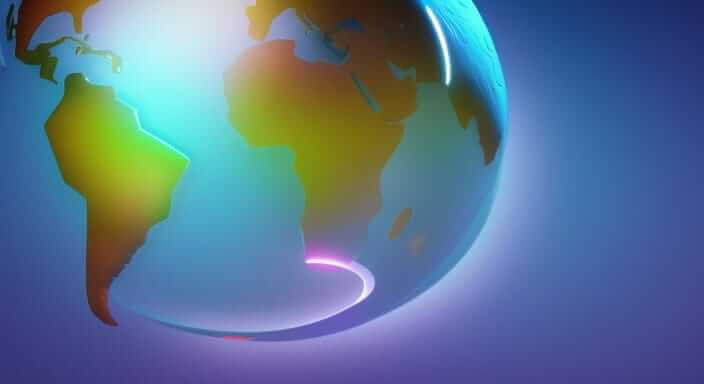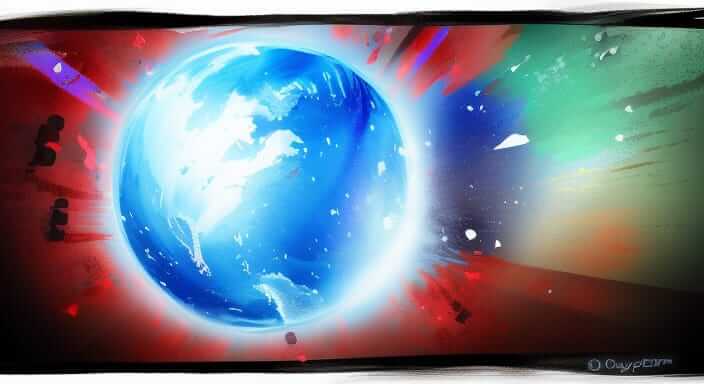Get ready to unravel the mysteries of the ozone layer! In this enlightening post, we present you with 10 crucial facts that shed light on this atmospheric marvel. From its formation and location to the reasons behind its depletion, we’ll delve into the science behind the ozone layer.
The ozone layer refers to a region of Earth’s stratosphere, approximately 10 to 50 kilometers (6 to 30 miles) above the Earth’s surface, where a higher concentration of ozone (O3) molecules is present. Ozone is a molecule composed of three oxygen atoms bonded together.
The ozone layer plays a crucial role in protecting life on Earth by absorbing most of the Sun’s ultraviolet (UV) radiation, particularly the harmful ultraviolet-B (UV-B) and ultraviolet-C (UV-C) wavelengths. This absorption process prevents the majority of these harmful rays from reaching the Earth’s surface.
UV radiation can have detrimental effects on living organisms, including increased risk of skin cancer, cataracts, and damage to the immune system. It can also have harmful impacts on ecosystems, such as reducing crop yields, affecting marine life, and disrupting the balance of ecosystems.
The formation and maintenance of the ozone layer are mainly attributed to the presence of ozone-depleting substances (ODS), such as chlorofluorocarbons (CFCs), halons, carbon tetrachloride, and other similar compounds. These substances were commonly used in various industrial and consumer applications, such as aerosol propellants, refrigerants, and solvents.
Due to their stability and long atmospheric lifetimes, ODS can rise to the stratosphere where they are broken down by sunlight, releasing chlorine and bromine atoms. These atoms can catalytically destroy ozone molecules, leading to the thinning of the ozone layer.
The discovery of the depletion of the ozone layer led to international efforts to reduce and eliminate the production and consumption of ozone-depleting substances. The Montreal Protocol on Substances that Deplete the Ozone Layer, established in 1987, has been successful in significantly reducing the production and use of ODS, leading to the gradual recovery of the ozone layer.
Protecting the ozone layer remains crucial for maintaining a healthy environment and safeguarding life on Earth from the harmful effects of UV radiation. Continued international cooperation and adherence to the regulations outlined in the Montreal Protocol are essential for the long-term preservation of the ozone layer.

Characteristics Of Ozone Layer
1. Study of the ozone layer
The ozone layer was discovered in 1913 by two physicists; Charles Fabry and Henri Buisson. Between the years 1928 and 1958 the meteorologist Dobson established a system for measuring the entire ozone layer around the world.
This system continues to operate until today. In fact, the Dobson units that measure ozone were established in their name as a tribute to their work.
2. Constitution
The ozone layer is made up of ozone molecules. Specifically, each molecule of the ozone layer is composed of 3 oxygen atoms (O3). In the outer layer of the same, there is a significant amount of ozone that is responsible for slowing down 90% of ultraviolet rays (Uv rays).
3. Weakening of the ozone layer
The weakening of the ozone layer refers to a phenomenon where the concentration of ozone molecules in the stratosphere is reduced, leading to a decrease in its protective ability against harmful ultraviolet (UV) radiation. This weakening is primarily caused by the release of ozone-depleting substances (ODS) into the atmosphere.
Ozone-depleting substances, such as chlorofluorocarbons (CFCs), halons, carbon tetrachloride, and other similar compounds, are synthetic chemicals that were widely used in various industrial and consumer applications. These substances are stable and can remain in the atmosphere for a long time, eventually reaching the stratosphere.
Once in the stratosphere, ozone-depleting substances are broken down by the high-energy UV radiation, releasing chlorine and bromine atoms. These atoms act as catalysts, meaning they can participate in multiple reactions without being consumed themselves. Chlorine and bromine atoms can then react with ozone molecules, breaking them apart and reducing the overall concentration of ozone.
The consequences of a weakened ozone layer are significant. Increased levels of UV radiation reach the Earth’s surface, posing health risks to humans, animals, and plants. UV-B and UV-C radiation can cause skin cancer, cataracts, and suppress immune systems. It can also negatively impact ecosystems, including marine ecosystems, crops, and phytoplankton, which are vital for the marine food chain.
The awareness of ozone layer depletion and its potential consequences led to international action. The Montreal Protocol on Substances that Deplete the Ozone Layer, adopted in 1987, aims to phase out the production and use of ozone-depleting substances. As a result of this agreement, the production and consumption of many ozone-depleting substances have been significantly reduced, leading to a gradual recovery of the ozone layer.
However, it’s important to note that the recovery of the ozone layer is a slow process, as ozone-depleting substances can persist in the atmosphere for many years. Continued efforts to monitor and enforce the regulations outlined in the Montreal Protocol are essential to ensure the recovery and long-term protection of the ozone layer.

4. Ozone layer destruction
Ozone layer destruction refers to the process by which the ozone layer in Earth’s stratosphere is significantly depleted or thinned, resulting in a decrease in the concentration of ozone molecules. This destruction is primarily caused by the release of certain human-made chemicals known as ozone-depleting substances (ODS).
The most significant contributors to ozone layer destruction are chlorofluorocarbons (CFCs), halons, carbon tetrachloride, and similar compounds. These substances were commonly used in various industrial and consumer applications, including aerosol propellants, refrigerants, foam-blowing agents, and fire extinguishers. They have long atmospheric lifetimes, meaning they can remain in the atmosphere for several years or even decades.
Once released into the atmosphere, ozone-depleting substances are transported to the stratosphere by natural processes. In the stratosphere, they are broken down by the high-energy UV radiation from the Sun, releasing chlorine and bromine atoms. These atoms are highly reactive and can participate in catalytic cycles that lead to the destruction of ozone molecules.
Chlorine and bromine atoms react with ozone, causing the ozone molecules to break apart. A single chlorine or bromine atom can destroy multiple ozone molecules before being regenerated and reused in the destruction process. This catalytic destruction process leads to a reduction in the overall concentration of ozone in the ozone layer.
The consequences of ozone layer destruction are significant and far-reaching. Increased levels of harmful ultraviolet-B (UV-B) and ultraviolet-C (UV-C) radiation reach the Earth’s surface, posing risks to human health, ecosystems, and the environment. UV-B and UV-C radiation can cause skin cancer, cataracts, and damage to the immune system. It can also disrupt ecosystems, harm marine life, and affect the growth of plants and crops.
The recognition of the detrimental effects of ozone layer destruction led to international efforts to address the issue. The Montreal Protocol on Substances that Deplete the Ozone Layer, established in 1987, is a global agreement aimed at phasing out the production and use of ozone-depleting substances. Through the implementation of the Montreal Protocol and subsequent amendments, the production and consumption of many ozone-depleting substances have been significantly reduced, leading to the gradual recovery of the ozone layer.
While progress has been made in repairing the ozone layer, it is a slow process due to the long lifetimes of ozone-depleting substances in the atmosphere. Continued adherence to the regulations of the Montreal Protocol and ongoing monitoring of ozone levels are crucial to ensure the full recovery and long-term protection of the ozone layer.
5. Main halocarbons
The combustion gases are one of the main pollutants.
The main source of halocarbons, that is, components that destroy the ozone layer are:
Chemical elements for human use. The worst are the chlorofluorocarbons, an example of these are the gases that cars expel from the exhaust pipes; the toxic fumes that leave the factories (which are mostly gray or black). These chlorofluorocarbons can remain in small particles in the air for up to 100 years from their emission, destroying the ozone layer to a great extent.
Aerosols of all kinds. These aerosols contain a substance that, by pressing the aerosol, the chlorofluorocarbon particles remain in the air, also damaging the ozone layer. Other products that contain chlorofluorocarbons are air conditioning systems, freezers, refrigerators and synthetic foams.
6. Effects of ultraviolet rays
When the ozone layer is very permeable to ultraviolet rays by the chemical products (halocarbons) that damage it, it breaks down, allowing these rays to reach the Earth’s surface, damaging the life of all living beings. This produces what was called an ozone hole.
7. Consequences for the human being
The destruction of the ozone layer has significant consequences for human beings. Increased levels of ultraviolet (UV) radiation reaching the Earth’s surface as a result of ozone depletion can have various health impacts:
- Skin Cancer: Prolonged exposure to UV radiation, especially UV-B radiation, is a major risk factor for skin cancer, including both non-melanoma and melanoma types. Ozone depletion allows more UV radiation to reach the Earth’s surface, increasing the incidence of skin cancer cases.
- Eye Damage: UV radiation can cause damage to the eyes, including cataracts, a clouding of the lens that can lead to visual impairment or blindness. Increased UV radiation due to ozone depletion raises the risk of developing cataracts and other eye-related disorders.
- Weakened Immune System: UV radiation can suppress the immune system, making individuals more susceptible to infections and diseases. A weakened immune system can compromise the body’s ability to fight off pathogens and recover from illnesses.
- Sunburns and Premature Aging: Higher levels of UV radiation can cause sunburns, which are painful and increase the risk of long-term skin damage. UV radiation can also accelerate the aging process of the skin, leading to wrinkles, age spots, and other signs of premature aging.
- Allergies and Sensitivities: UV radiation can trigger allergic reactions and sensitivities in some individuals, leading to conditions such as polymorphic light eruption (PLE) or photoallergic dermatitis.
It’s important to note that the severity of these health effects depends on factors such as an individual’s geographic location, the intensity of UV radiation, personal behavior (such as sun exposure habits), and the use of protective measures like sunscreen and protective clothing.
In addition to the direct health impacts, ozone layer depletion can have indirect effects on society and the environment. For example, it can lead to reduced agricultural productivity due to UV damage to crops, affecting food security. It can also disrupt ecosystems and marine life, impacting fisheries and biodiversity.
Recognizing the risks associated with ozone depletion, international efforts have been made to mitigate its effects through the Montreal Protocol and its amendments. These measures aim to reduce the production and use of ozone-depleting substances, promoting the recovery and long-term protection of the ozone layer to safeguard human health and the environment.

8. Consequences for plant and animal life
Both plants and animals are affected by the ozone hole; Ultraviolet rays change the chemical composition of both plants and crops.
The ozone hole has already reached aquatic life, affecting and altering the balance between aerobic and anaerobic beings that live there. This produces that the waters that were drinkable in a natural way, become untreated, altering this ecosystem.
9. Population awareness
One of the best ways to start is the awareness of the irreversible damage, the harmful effects it produces on the environment and on the health of all living beings in order to start acting.
It is also important to recognize that this problem is current and that, in order to prevent harmful effects from continuing or worsening, it is necessary to implement environmental policies from the countries but also from small and medium-sized cities as well as from the nuclear family.
10. Immediate and individual solutions
There are several immediate and individual solutions that individuals can adopt to protect themselves from the harmful effects of increased UV radiation resulting from ozone layer depletion:
- Use Sunscreen: Apply sunscreen with a high Sun Protection Factor (SPF) regularly and generously to exposed skin, even on cloudy days. Choose a broad-spectrum sunscreen that protects against both UVA and UVB radiation.
- Wear Protective Clothing: Cover exposed skin by wearing long-sleeved shirts, long pants, wide-brimmed hats, and sunglasses with UV protection. This helps to minimize direct exposure to UV radiation.
- Seek Shade: When outdoors, seek shade, especially during peak UV radiation hours, typically between 10 am and 4 pm. Staying in the shade reduces direct exposure to UV rays.
- Limit Outdoor Activities: Reduce the time spent outdoors during peak UV hours when the sun’s rays are the strongest. Plan outdoor activities for early morning or late afternoon when the UV radiation is less intense.
- Be Mindful of Reflective Surfaces: Remember that UV radiation can be reflected off surfaces such as water, sand, snow, and concrete. Take precautions and apply protective measures even when in the vicinity of these reflective surfaces.
- Use UV-Protective Eyewear: Wear sunglasses that block 100% of both UVA and UVB radiation to protect your eyes from UV damage. Look for sunglasses labeled with UV400 or 100% UV protection.
- Check the UV Index: Stay informed about the daily UV index in your area. The UV index provides information about the strength of UV radiation and helps you plan outdoor activities accordingly.
- Avoid Tanning Beds: Avoid using tanning beds, as they emit high levels of UV radiation and can increase the risk of skin cancer.
- Educate and Advocate: Spread awareness about the importance of protecting the ozone layer and the risks associated with increased UV radiation. Encourage others to adopt protective measures and support initiatives aimed at environmental preservation.
While individual actions are essential, it is also crucial to support broader efforts for environmental protection and the implementation of international agreements like the Montreal Protocol, which aims to phase out ozone-depleting substances. Collective action is key to preserving the ozone layer and mitigating the impacts of ozone depletion on human health.